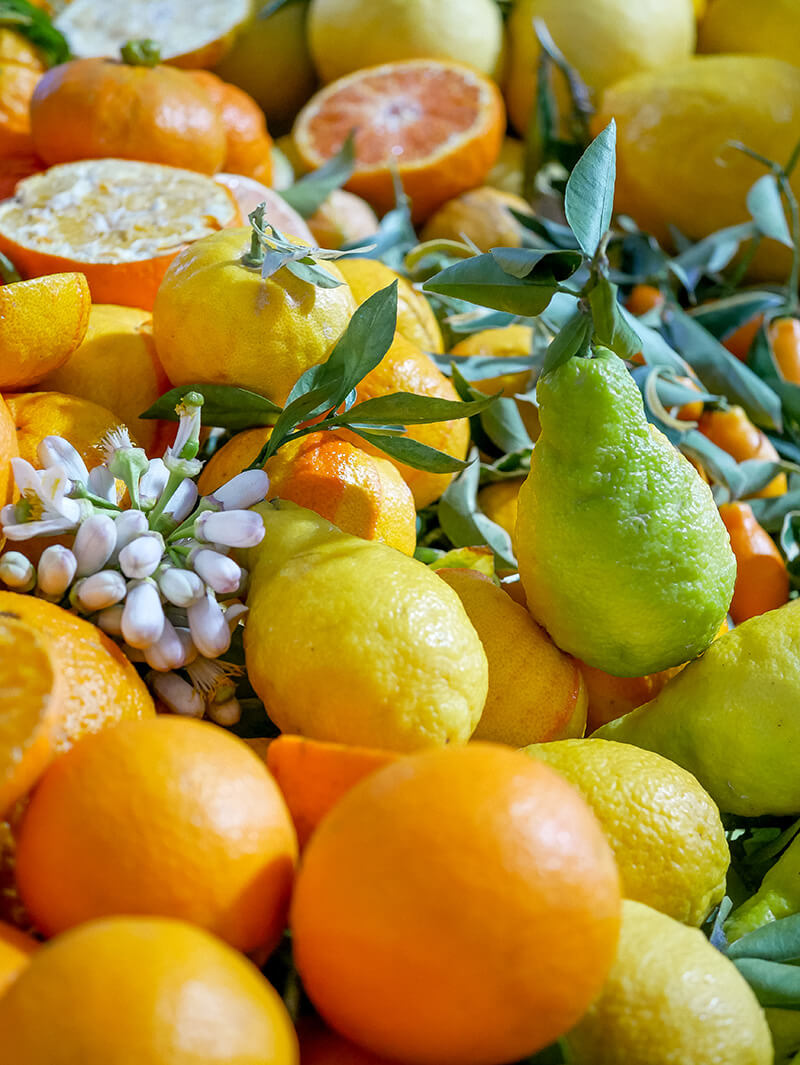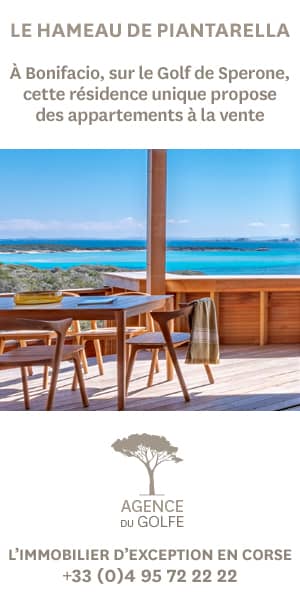
It is in San Giuliano, in Costa Verde, on Corsica’s eastern hillsides, that the Inra and Cirad citrus conservatory can be found. With over 1,000 varieties of citrus, this collection is one of the world’s largest and most beautiful. Clementines, oranges, navel, blond, Maltese and blood oranges, lemons, limes, pomelos, citrons, grapefruit all site alongside lesser known citrus fruit such as caviar limes with their distinctive, spherical flesh, Japanese citrus such as Yuzu, Sudachi, Kabosu lemons and limes which are sweet rather than acidic.
These varieties of citrus fruit are lovingly cultivated, in the field, across more than 13 hectares of land.
Set up sixty years ago, and continually expanded, over the course of so many travels by Inra and Cirad researchers, the aim of this conservatory is to preserve genetic material and distribute it under the right sanitary conditions.
©Yann Frolicher_INRA
[/et_pb_text][et_pb_text _builder_version=”3.0.106″ background_size=”initial” background_position=”top_left” background_repeat=”repeat” use_border_color=”off” border_style=”solid” /][/et_pb_column][/et_pb_row][et_pb_row custom_padding=”||0px|” padding_top_1=” ” padding_right_1=” ” padding_bottom_1=”0px” padding_left_1=” ” disabled_on=”off|on|on” _builder_version=”3.0.47″ background_size=”initial” background_position=”top_left” background_repeat=”repeat”][et_pb_column type=”4_4″][et_pb_text admin_label=”Exergue” _builder_version=”3.0.106″ text_font=”Open Sans Light||||” text_font_size=”2em” text_font_size_phone=”2em” text_font_size_last_edited=”on|phone” text_text_color=”#000000″ text_line_height=”1.3em” background_color=”#ffffff” background_size=”initial” background_position=”top_left” background_repeat=”repeat” custom_margin=”-120px|||” custom_padding=”10px|10px|10px|10px” custom_css_main_element=”border-top:solid 10px” use_border_color=”off” border_style=”solid” saved_tabs=”all”] Avec plus de 1 000 variétés d’agrumes, cette collection est l’une des plus importantes et des plus belles du monde. Partager [/et_pb_text][/et_pb_column][/et_pb_row][/et_pb_section][et_pb_section bb_built=”1″ _builder_version=”3.0.106″ max_width=”65%” max_width_last_edited=”on|phone” module_alignment=”center” prev_background_color=”#000000″ next_background_color=”#000000″][et_pb_row _builder_version=”3.0.106″][et_pb_column type=”4_4″][et_pb_text _builder_version=”3.0.106″ background_layout=”light”]This collection represents an abundant resource for researchers in their studies and recent work undertaken in collaboration with Spanish and American teams has provided a better understanding of the genetic origins of citrus fruit. It has thus come to light that there were four ancestral groups which gave rise to all cultivated species: citron trees, grapefruit trees, mandarin trees and papeda trees.
Several thousand years ago, in the early days of commercial exchange, man came into contact with these citrus varieties which then began to cross-pollinate.
This then led to the creation of bitter oranges, as a result of the combination of a mandarin tree and a grapefruit tree, orange trees (¾ mandarin tree, ¼ grapefruit tree), lemon trees (½ citron tree, ½ bitter orange tree)…
As a wonderful resource for innovation, this conservatory enables researchers to naturally create new varieties. They are working together with Corsican citrus producers in an attempt to select the fruit which will appeal to consumers most: a mandarin that would arrive on the market after the Corsican clementine, a lime better suited to the Corsican climate or a new pomelo? Some among these promising varieties have already been tested throughout the orchards of the île de Beauté, as part of a project entitled InnovAgrumes. However, while you might find them on the stalls of a local market but don’t get too impatient just yet as it will be another 20 years before they are marketed more widely.
[/et_pb_text][/et_pb_column][/et_pb_row][/et_pb_section][et_pb_section bb_built=”1″ fullwidth=”on” _builder_version=”3.0.106″ prev_background_color=”#000000″ next_background_color=”#000000″][et_pb_fullwidth_image src=”https://www.luxury-estate-magazine.com/wp-content/uploads/2019/07/Luxury-Estate-INRA-CIRAD-01.jpg” _builder_version=”3.0.106″ alt=”conservatoire des agrumes” show_in_lightbox=”off” url_new_window=”off” use_overlay=”off” /][/et_pb_section][et_pb_section bb_built=”1″ admin_label=”section” _builder_version=”3.0.47″ custom_padding=”0px|0px|0px|0px” custom_padding_tablet=”0px|0px|0px|0px” transparent_background=”off” padding_mobile=”on” prev_background_color=”#ffffff” next_background_color=”#ffffff”][et_pb_row admin_label=”row” custom_padding=”0px|0px|0px|0px” padding_mobile=”on” column_padding_mobile=”on” _builder_version=”3.0.47″ background_size=”initial” background_position=”top_left” background_repeat=”repeat”][et_pb_column type=”1_3″][/et_pb_column][et_pb_column type=”1_3″][/et_pb_column][et_pb_column type=”1_3″][et_pb_text _builder_version=”3.0.106″ text_font_size=”12px” background_color=”#ffffff” background_size=”initial” background_position=”top_left” background_repeat=”repeat” custom_margin=”-10%|||” custom_padding=”5%|5%|5%|5%” use_border_color=”off” border_style=”solid”]©Thibaut Poullet_INRA
[/et_pb_text][/et_pb_column][/et_pb_row][/et_pb_section][et_pb_section bb_built=”1″ admin_label=”section” custom_padding_last_edited=”on|desktop” _builder_version=”3.0.47″ custom_padding=”0px|0px|37.9062px|0px” custom_padding_tablet=”50px|0|50px|0″ transparent_background=”off” padding_mobile=”off” prev_background_color=”#ffffff” next_background_color=”#000000″][et_pb_row admin_label=”row” custom_padding=”0px|0px|18.9531px|0px” padding_mobile=”off” column_padding_mobile=”on” disabled_on=”on|on|off” _builder_version=”3.0.47″ background_size=”initial” background_position=”top_left” background_repeat=”repeat”][et_pb_column type=”1_4″][/et_pb_column][et_pb_column type=”1_2″][et_pb_cta admin_label=”Coordonnées” title=”Conservatoire des Agrumes de l’INRA et du CIRAD” button_url=”https://www.corse.inra.fr” button_text=”www.corse.inra.fr” _builder_version=”3.0.106″ header_font_size=”18px” body_font_size=”14px” background_size=”initial” background_position=”top_left” background_repeat=”repeat” custom_button=”on” button_text_size=”15px” button_use_icon=”off” button_text_color_hover=”#000000″ button_bg_color_hover=”#ffffff” use_border_color=”off” border_color=”#ffffff” border_width=”1px” border_style=”solid”]20230 San Giuliano
[/et_pb_cta][/et_pb_column][et_pb_column type=”1_4″][/et_pb_column][/et_pb_row][et_pb_row admin_label=”row” custom_padding=”0px|0px|18.9531px|0px” custom_padding_phone=”||0px|” padding_1_phone=”|||” padding_1_last_edited=”off|desktop” disabled_on=”off|off|on” custom_padding_last_edited=”on|phone” _builder_version=”3.0.47″ background_size=”initial” background_position=”top_left” background_repeat=”repeat”][et_pb_column type=”4_4″][et_pb_cta admin_label=”Coordonnées” title=”Conservatoire des Agrumes de l’INRA et du CIRAD” button_url=”https://www.corse.inra.fr” button_text=”www.corse.inra.fr” _builder_version=”3.0.106″ header_font_size=”18px” body_font_size=”14px” background_size=”initial” background_position=”top_left” background_repeat=”repeat” custom_button=”on” button_text_size=”15px” button_use_icon=”off” button_text_color_hover=”#000000″ button_bg_color_hover=”#ffffff” use_border_color=”off” border_color=”#ffffff” border_width=”1px” border_style=”solid”]20230 San Giuliano
[/et_pb_cta][/et_pb_column][/et_pb_row][/et_pb_section]



